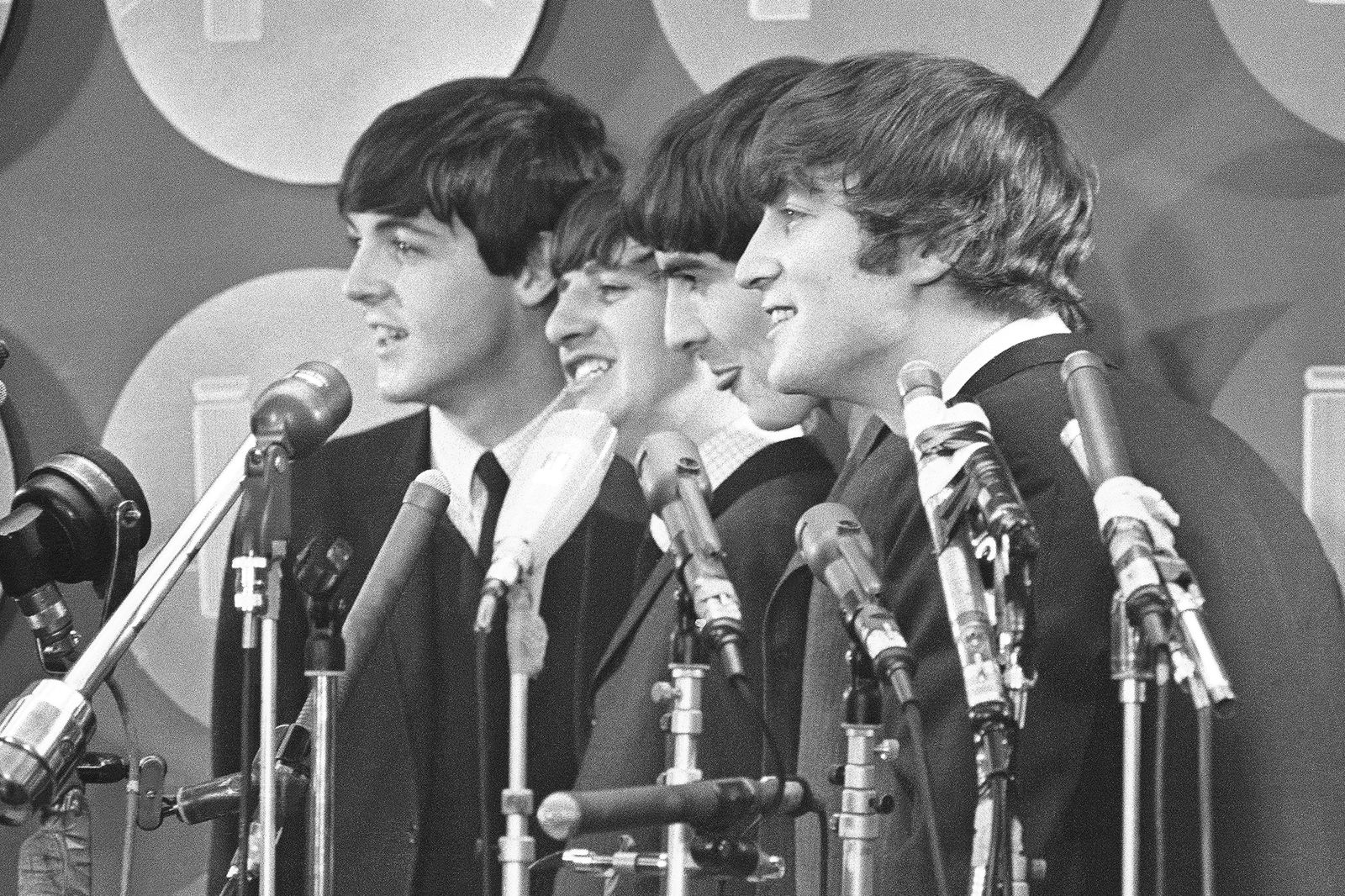Guilty Pleasures

By NewsPress Now
Beatles to get a Fab Four of biopics, with a movie for each
NEW YORK | The Beatles are getting the big-screen biopic treatment in not just one film, but a Fab Four of movies that will give each band member their own spotlight — all of which are to be directed by Sam Mendes.
For the first time, the Beatles, long among the stingiest rights granters, are giving full life and music rights to a movie project. Sony Pictures announced Monday a deal that may dwarf all music biopics that have come before it, with the stories of Paul McCartney, John Lennon, George Harrison and Ringo Starr spread out over a quartet of films.
The films, conceived by Mendes, are expected to roll out theatrically in innovative fashion, with the movies potentially coexisting or intersecting in theaters. Precise release plans will be announced at a later date. Sony is targeting 2027 for their release.
McCartney, Starr and the families of John Lennon and George Harrison have all signed off on the project through the band’s Apple Corps. Ltd. Sony Music Publishing controls the rights to the majority of Beatles songs.
“I’m honored to be telling the story of the greatest rock band of all time, and excited to challenge the notion of what constitutes a trip to the movies,” Mendes said in a statement.
Each film will be from the perspective of a Beatle.
“We intend this to be a uniquely thrilling, and epic cinematic experience: four films, told from four different perspectives which tell a single story about the most celebrated band of all time,” said producer Pippa Harris. “To have The Beatles’ and Apple Corps’ blessing to do this is an immense privilege.”
The Beatles’ most famous forays into film were in their early years. Between 1964 and 1970, they appeared in five movies, including “A Hard Day’s Night” (1964) and the animated “Yellow Submarine” (1968). They’ve, of course, been the subject of many documentaries, most recently Peter Jackson’s 2021 “The Beatles: Get Back.”
In 2023, the Beatles reunited with the aid of artificial intelligence in the newly released song “Now and Then.” The recording was made possible by technology used by Jackson on “Get Back,” and featured a music video made by the New Zealand director.
Attempts to dramatize the Beatles’ story have been more sporadic and less impactful. A 1979 biopic, made when Lennon was still alive, called “The Birth of the Beatles” was produced with Beatles original drummer Pete Best as an adviser. The 1994 indie drama “Backbeat” chronicled Lennon’s relationship with Stuart Sutcliffe before the Beatles were famous. “Nowhere Boy” (2009) starred Aaron Taylor-Johnson as a teenage Lennon.
But in the last decade, music biopics have become big business. Box-office hits like “Bohemian Rhapsody,””Rocketman” and “Elvis” have sent Hollywood executives chasing the next jukebox blockbuster. Over Presidents Day weekend, “Bob Marley: One Love,” produced with the Marley estate, was the No. 1 movie in theaters. A Michael Jackson biopic is in production.
“Theatrical movie events today must be culturally seismic. Sam’s daring, large-scale idea is that and then some,” said Tom Rothman, chair and chief executive of Sony Pictures’ Motion Picture Group.
The combination of Mendes’ team “with the music and the stories of four young men who changed the world, will rock audiences all over the globe,” Rothman said. “We are deeply grateful to all parties and look forward ourselves to breaking some rules with Sam’s uniquely artistic vision.”
Murder trial in Tupac Shakur killing pushed back
LAS VEGAS | A trial date has been pushed back from June to November for a former Los Angeles-area gang leader charged with killing hip-hop music icon Tupac Shakur in 1996 in Las Vegas, and his new attorney said Tuesday that he expects to be able to post bail soon to be released from jail to house arrest.
Duane “Keffe D” Davis stood in custody and told Clark County District Court Carli Kierny that people who are willing to help him post $750,000 bail don’t want to appear in court for a “source hearing” to show that the money was legally obtained.
“I’ve got family that is hesitant to come in here and help me out on the bail because of the media and the circus that’s going on,” Davis said.
Davis, 60, is originally from Compton, California. He is the only person still alive who was in a car from which shots were fired in September 1996, killing Shakur and wounding rap mogul Marion “Suge” Knight in another car at a traffic signal near the Las Vegas Strip. Knight, now 58, is serving 28 years in a California prison for an unrelated fatal shooting in the Los Angeles area in 2015.
Kierny acknowledged that Davis’ lawyer, Carl Arnold, was new to Davis’ case and that prosecutors are still providing evidentiary material to the defense. She reset the trial date from June 3 to Nov. 4.
Arnold told reporters outside the courtroom that he believed Davis may be able this week to finish raising the 10% bail amount, or $75,000, to obtain a bail bond and be freed to house arrest with electronic monitoring. A source hearing could take place within 30 days, he said.
Davis was arrested in September, 27 years after the Shakur killing, outside his home in suburban Henderson. He pleaded not guilty in November to first-degree murder and has remained jailed at the Clark County Detention Center in Las Vegas. If convicted, he could spend the rest of his life in prison.
Prosecutors say they have strong evidence that Davis incriminated himself during police and media interviews since 2008, and in his own 2019 tell-all memoir of life leading a Compton street gang.
Arnold on Tuesday echoed comments by Davis’ previous attorneys, telling reporters that Davis wrote the book to make money, as others including a police investigator had done. He also noted that police and prosecutors do not have a murder weapon or the car from which shots were fired. He said the state will have to prove that Davis was in Las Vegas the night Shakur was shot.
Davis wrote that he was promised immunity from prosecution in 2010 when he told authorities in Los Angeles what he knew about the fatal shootings of Shakur and rival rapper Christopher Wallace six months later in Los Angeles. Wallace was known as The Notorious B.I.G. or Biggie Smalls.
Shakur had five No. 1 albums, was nominated for six Grammy Awards and was inducted in 2017 into the Rock & Roll Hall of Fame. He received a posthumous star last year on the Hollywood Walk of Fame.
YouTube mom Ruby Franke apologizes
at sentencing
SALT LAKE CITY | Ruby Franke, a Utah mother of six who gave parenting advice to millions via a once-popular a YouTube channel, shared a tearful apology to her children for physically and emotionally abusing them before a judge sentenced her Tuesday to serve up to 60 years in prison.
Franke told Judge John J. Walton that she would not argue for a shorter sentence before she stood to thank local police officers, doctors and social workers for being the “angels” who saved her children from her at a time when she says she was under the influence of her business partner, Jodi Hildebrandt. The Utah mental health counselor, who had been hired to work with Franke’s youngest son before going into business with Franke, also received a prison sentence Tuesday of up to 60 years.
“I’ll never stop crying for hurting your tender souls,” Franke said to her children, who were not present at the sentencing hearing. “My willingness to sacrifice all for you was masterfully manipulated into something very ugly. I took from you all that was soft and safe and good.”
Franke and Hildebrandt had each pleaded guilty to four counts of aggravated child abuse for trying to convince Franke’s two youngest children that they were evil, possessed and needed to be punished to repent. The women were arrested at Hildebrandt’s house in the southern Utah city of Ivins last August after Franke’s 12-year-old son escaped through a window and asked a neighbor to call the police, according to a 911 call released by the St. George Police Department.
The boy was thin, covered in wounds and had duct tape around his ankles and wrists. He told investigators that Hildebrandt had put ropes on his limbs and used cayenne pepper and honey to dress his cuts, according to a search warrant.
State prosecuting attorney Eric Clarke described the environment in which Franke and Hildebrandt had kept the kids as “a concentration camp-like setting,” a term most strongly associated with the camps established by the Nazis to starve, overwork and execute Jewish people and other minorities across Europe during the Holocaust.
While Franke has shown remorse and cooperated with attorneys, Clarke said, Hildebrandt has not and continues to place blame on the children. Hildebrandt’s attorney, Douglas Terry, said his client is not the remorseless woman she has been portrayed to be and accepts responsibility for her actions.
“I sincerely love these children. I desire for them to heal physically and emotionally,” Hildebrandt said Tuesday in court, reminding the judge that she accepted her plea deal instead of going to trial because she did not want the children to have to relive their trauma by testifying.
Hildebrandt pleaded guilty in December to four of her six counts of aggravated child abuse, and two counts were dismissed as part of her plea deal. Franke also pleaded guilty to four of her six charges and not guilty to two. Each charge carries a prison sentence of one to 15 years, which will run consecutively.
Franke and her husband, Kevin Franke, launched “8 Passengers” on YouTube in 2015 and amassed a large following as they documented their experiences raising six children. She later began working with Hildebrandt’s counseling company, ConneXions Classroom, offering parenting seminars, launching another YouTube channel and publishing content on their shared Instagram account, “Moms of Truth.”
Franke admitted in her plea deal to kicking her son while wearing boots, holding his head under water and closing off his mouth and nose with her hands. She and Hildebrandt said they also forced him into hours of physical labor in the summer heat without much food or water, causing dehydration and blistering sunburns. The boy was told that everything being done to him was an act of love, according to the plea agreements.
Hildebrandt also has admitted to coercing Franke’s youngest daughter, who was 9 at the time, to jump into a cactus multiple times and run barefoot on dirt roads until her feet blistered. The boy and girl were taken to the hospital after the arrests and placed in state custody along with two more of their siblings.
Prior to her 2023 arrest, Ruby Franke was already a divisive figure in the parent vlogging world. The Franke parents were criticized online for certain parenting decisions, including for banning their oldest son from his bedroom for seven months for pranking his younger brother. In other videos, Ruby Franke talked about refusing to take lunch to a kindergartener who forgot it at home and threatening to cut the head off a young girl’s stuffed toy to punish her for cutting things in the house.
The “8 Passengers” YouTube channel has since ended, and Kevin Franke has filed for divorce.
Both Franke and Hildebrandt have 30 days to appeal their sentences.
Once banned by communists, Poland dance garners UNESCO honors
WARSAW, Poland | Once banned by rulers dispatched from Moscow, Poland’s stately polonaise dance that nurtured the country’s spirit even through the dark years of its partition is now honored by UNESCO.
This 18th century dance has been performed from aristocratic balls to village celebrations, inspiring composers such as Johann Sebastian Bach and Frederic Chopin. It still figures prominently in big national occasions, pre-graduation balls and weddings.
On Dec. 5, this living tradition was ensconced into the UNESCO List of Intangible Cultural Heritage as a “form of joint celebration,” which “commemorates important moments in family and community life and symbolizes cooperation, reconciliation and equality.”
Poland’s Ministry of Culture and National Heritage, which petitioned for the dance’s inclusion into UNESCO’s list, said its initiative was met with huge public support.
“Thousands of people on Facebook and on other social media were supporting the (UNESCO) entry,” Joanna Cicha-Kuczynska of the ministry’s Department of Monuments Protection, told The Associated Press.
She said there is a huge community, including entire families, that dance the polonaise and pass the tradition on. Performed in pairs, it is led by the first and most prominent pair which improvises various figures, such as raising joined hands to form bridges under which other dancers can pass.
“The most important in the polonaise is that the whole group can jointly dance the choreography, and among the personal features the most important are the dignity of the men and the ethereal nature of the women,” said Marcin Pracki, a dancer of the Warsaw University’s Dance Theater “Warszawianka.”
Another “Warszawianka” dancer, Monika Fiugajska, said the dance’s simplicity is its strength.
“It is a very simple dance, the simplest among our national dances but at the same time it has an exceptional soul and one can express emotions in it in an exceptional way,” Fiugajska said.
This slow-paced procession dance evolved from a folk form called the “walking dance.” By the 18th century, under the French name of “Polonaise” — or Polish — it was widely danced among European nobility and opened royal balls.
In his 1773 book “The Present State of Music in Germany, the Netherlands and United Provinces,” British musician Charles Burney described the polonaise as being very popular across Saxony and especially at the court in Dresden where Poland’s elected king Augustus II The Strong had introduced it decades earlier.
Having inspired some of the greatest classical composers including Wolfgang Amadeus Mozart and Pyotr Tchaikovsky, the polonaise remains timeless, still opening the Vienna Opera Ball in carnival season.
“Undoubtedly, the polonaise merits being on the UNESCO list of world heritage because it is a dance with not only Polish but an international tradition, it is a generally recognized ballroom dance,” said Szymon Paczkowski, a musicology professor at the University of Warsaw.
Paczkowski said you don’t need to be a good dancer to participate — a slightly bent one knee at the right beat suffices.
During Poland’s more than a century of partition by neighboring Russia, Prussia and Austria, the polonaise expressed longing for the lost homeland, especially among the exiles and emigrees such as Chopin, who had emigrated to Paris. It was banned on territories that Russia took over.
The polonaise has become the opening dance at high school pre-graduation balls. Poland’s post-World War II communist authorities banned it from schools — because of its aristocratic and patriotic connotations — but students revived the tradition by the late 1960s.
Gabrysia Kosmal, 19, was among the students at Warsaw’s Mikolaj Rej high school who performed the polonaise this month.
“It is an exceptional moment, because you know, there happen to be conflicts among classmates, not everyone gets along with everyone, but we immerse in the music, dance together, it is a magical moment,” Kosmal said.
The polonaise is also a staple during national anniversaries, including the Nov. 11 Independence Day celebrations, when people are invited to dance in the streets with officials.
Natalia Bernat, an 18-year-old student who took part in a massive street dance in the central city of Lodz last month, said the polonaise brings people together at a time when the community needs it most and she believes “it’s worth it to cultivate this tradition.”
The leader of the Lodz street dance, Janusz Wielgosz, who donned a historic outfit for the occasion, said the polonaise is about beauty.
“It is a dance that is really very simple, with beautiful music and beautiful costumes. It is worth a try.”
—From AP reports



